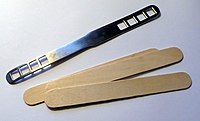
Photo from wikipedia
There is increasing demand for home-based devices for the treatment of dermatologic conditions and cosmesis. Commercially available devices include intense pulsed light, laser diodes, radiofrequency, light-emitting diodes, and ultraviolet B… Click to show full abstract
There is increasing demand for home-based devices for the treatment of dermatologic conditions and cosmesis. Commercially available devices include intense pulsed light, laser diodes, radiofrequency, light-emitting diodes, and ultraviolet B phototherapy. The objective of this report is to evaluate the current evidence regarding the efficacy and safety of home-based devices for the treatment of skin conditions. A systematic search of PubMed, Embase, and Cinahl was conducted on November 9, 2020 using PRISMA guidelines. Original research articles that investigated the efficacy and safety of home-based devices for dermatologic use were included. Bibliographies were screened for additional relevant articles. Strength of evidence was graded using the Oxford Centre for Evidence-Based Medicine guidelines. Clinical recommendations were then made based on the quality of the existing literature. After review, 37 clinical trials were included—19 were randomized controlled trials, 16 were case series, and 2 were non-randomized controlled trials. Ultimately, from our analysis, we recommend the home-based use of intense pulsed light for hair removal, laser diodes for androgenic alopecia, low power radiofrequency for rhytides and wrinkles, and light-emitting diodes for acne vulgaris. Trials investigating ultraviolet B phototherapy for psoriasis revealed mixed evidence for home treatments compared to clinic treatments. All devices had favorable safety profiles with few significant adverse events. Limitations to our review include a limited number of randomized controlled trials as well as a lack of data on the long-term efficacy and safety of each device.
Journal Title: Archives of Dermatological Research
Year Published: 2021
Link to full text (if available)
Share on Social Media: Sign Up to like & get
recommendations!